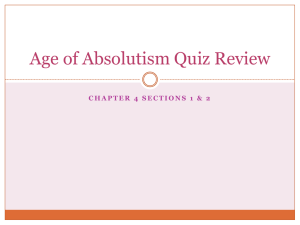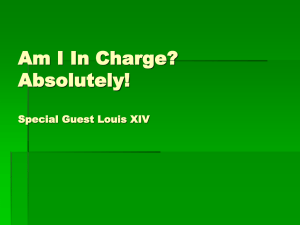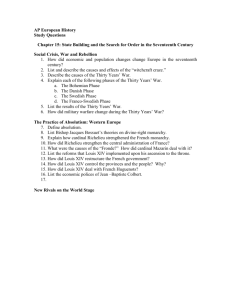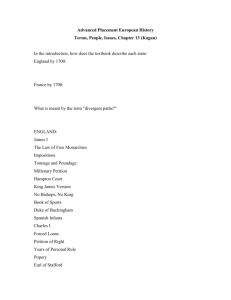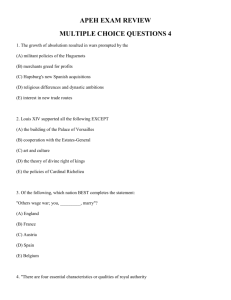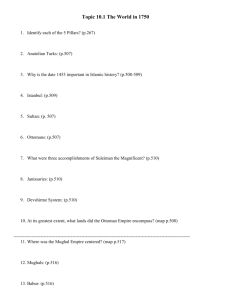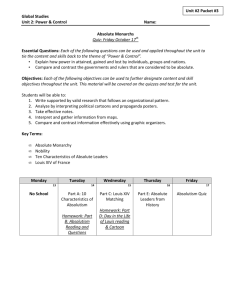Chapter 16- Absolutism and Constitutionalism in Western Europe
advertisement
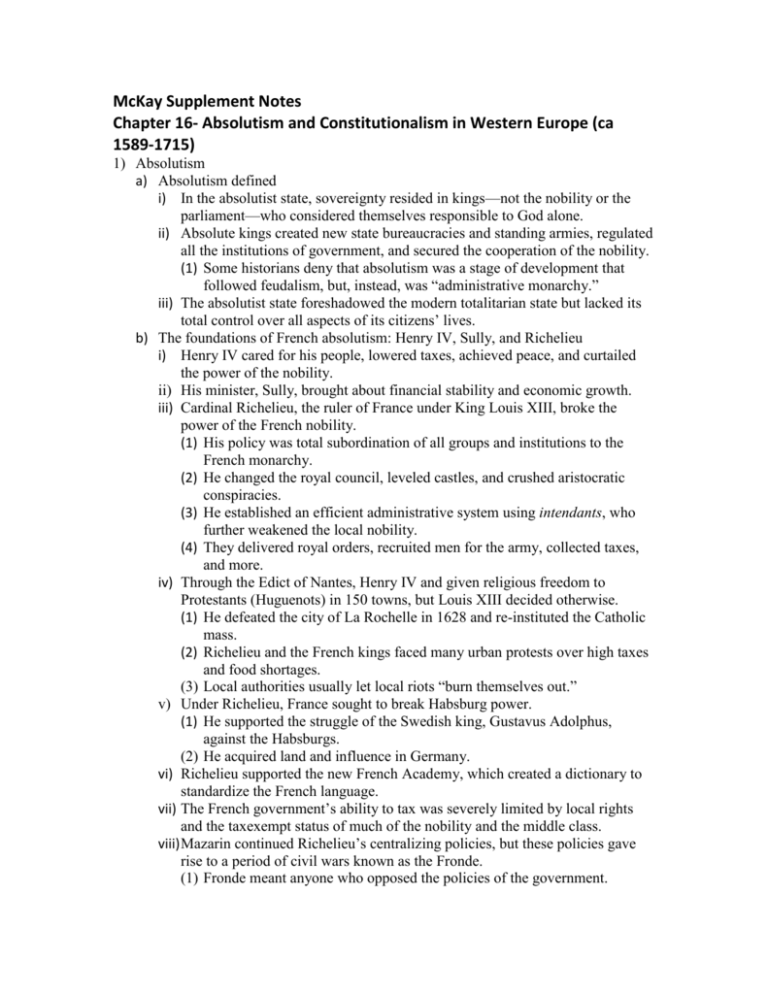
McKay Supplement Notes Chapter 16- Absolutism and Constitutionalism in Western Europe (ca 1589-1715) 1) Absolutism a) Absolutism defined i) In the absolutist state, sovereignty resided in kings—not the nobility or the parliament—who considered themselves responsible to God alone. ii) Absolute kings created new state bureaucracies and standing armies, regulated all the institutions of government, and secured the cooperation of the nobility. (1) Some historians deny that absolutism was a stage of development that followed feudalism, but, instead, was “administrative monarchy.” iii) The absolutist state foreshadowed the modern totalitarian state but lacked its total control over all aspects of its citizens’ lives. b) The foundations of French absolutism: Henry IV, Sully, and Richelieu i) Henry IV cared for his people, lowered taxes, achieved peace, and curtailed the power of the nobility. ii) His minister, Sully, brought about financial stability and economic growth. iii) Cardinal Richelieu, the ruler of France under King Louis XIII, broke the power of the French nobility. (1) His policy was total subordination of all groups and institutions to the French monarchy. (2) He changed the royal council, leveled castles, and crushed aristocratic conspiracies. (3) He established an efficient administrative system using intendants, who further weakened the local nobility. (4) They delivered royal orders, recruited men for the army, collected taxes, and more. iv) Through the Edict of Nantes, Henry IV and given religious freedom to Protestants (Huguenots) in 150 towns, but Louis XIII decided otherwise. (1) He defeated the city of La Rochelle in 1628 and re-instituted the Catholic mass. (2) Richelieu and the French kings faced many urban protests over high taxes and food shortages. (3) Local authorities usually let local riots “burn themselves out.” v) Under Richelieu, France sought to break Habsburg power. (1) He supported the struggle of the Swedish king, Gustavus Adolphus, against the Habsburgs. (2) He acquired land and influence in Germany. vi) Richelieu supported the new French Academy, which created a dictionary to standardize the French language. vii) The French government’s ability to tax was severely limited by local rights and the taxexempt status of much of the nobility and the middle class. viii) Mazarin continued Richelieu’s centralizing policies, but these policies gave rise to a period of civil wars known as the Fronde. (1) Fronde meant anyone who opposed the policies of the government. (2) Many people of the aristocracy and the middle classes opposed government centralization and new taxes; rebellion was widespread. (3) The conflicts hurt the economy and convinced the new king, Louis XIV, that civil war was destructive of social order and that absolute monarchy was the only alternative to anarchy. 2) The absolute monarchy of Louis XIV a) Louis XIV, the “Sun King,” was a devout Catholic who believed that God had established kings as his rulers on earth. b) He feared the nobility and was successful in collaboration with them to enhance both aristocratic prestige and royal power. c) He made the court at Versailles a fixed institution and used it as a means of preserving royal power and as the center of French absolutism. i) The architecture and art of Versailles were a means of carrying out state policy—a way to overawe his subjects and foreign powers. ii) The French language and culture became the international style. iii) The court at Versailles was a device to undermine the power of the aristocracy by separating power from status. iv) A centralized state, administered by a professional class taken from the bourgeoisie, was formed. d) Financial and economic management under Louis XIV’s minister, Colbert i) Louis’s wars were expensive, but the tax farmers took much of the taxes while the nobility paid no taxes at all. ii) Mercantilism is a collection of governmental policies for the regulation of economic activities by and for the state. iii) Louis XIV’s finance minister, Colbert, tried to achieve a favorable balance of trade and make France selfsufficient so the flow of gold to other countries would be halted. (1) Colbert encouraged French industry, enacted high foreign tariffs, and created a strong merchant marine. (2) He hoped to make Canada part of a French empire. (3) Though France’s industries grew and the commercial classes prospered, its agricultural economy suffered under the burdens of heavy taxation, population decline, and poor harvests. e) The revocation of the Edict of Nantes i) In 1685, Louis revoked the Edict of Nantes—then destroyed Protestant churches and schools; many Protestants fled the country. ii) Why? Because Louis XIV hated division within France—and because most people supported this policy. f) French classicism in art and literature i) . French classicism imitated and resembled the arts of the ancients and the Renaissance. ii) Poussin best illustrates classical idealism in painting. iii) Louis XIV was a patron of the composers Lully, Couperin, and Charpentier. iv) The comedies of Molière and the tragedies of Racine best illustrate the classicism in French theater. 3) Louis XIV’s wars a) Louis kept France at war for 33 of the 54 years of his personal rule; the Marquis de Louvois created a professional army for Louis. i) The French army under Louis XIV was modern because the state, rather than the nobles, employed the soldiers. (1) Louis himself took personal command of the army. (2) Martinet created a rigid but effective system of training. b) Louis continued Richelieu’s expansionist policy. i) In 1667, he invaded Flanders and gained twelve towns. ii) By the treaty of Nijmegen (1678) he gained some Flemish towns and all of FrancheComté. iii) Strasbourg was taken in 1681 and Lorraine in 1684, but the limits of his expansion had been met. iv) Louis fought the new Dutch king of England, William III, and the League of Augsburg in a war. (1) The Banks of Amsterdam and England financed his enemies. (2) Louis’s heavy taxes fell on the peasants, who revolted. v) This led to the War of the Spanish Succession (1701-1713), which was over the issue of the succession to the Spanish throne: Louis claimed Spain but was opposed by the Dutch, English, Austrians, and Prussians. (1) The war was also an attempt to preserve the balance of power in Europe and to check France’s commercial power overseas. (2) A Grand Alliance of the English, Dutch, Austrians, and Prussians was formed in 1701 to fight the French. (3) Eugene of Savoy and Churchill of England led the alliance to victory over Louis. (4) The war was concluded by the Peace of Utrecht in 1713, which forbade the union of France and Spain. (5) The war ended French expansionism and left France on the brink of bankruptcy, with widespread misery and revolts. 4) The decline of absolutist Spain in the seventeenth century a) Spain had developed an absolutist monarchy but by the 1590s it was in decline. i) Fiscal disorder, political incompetence, the lack of a strong middle class, population decline, intellectual isolation, and psychological malaise contributed to its decline. ii) The Dutch and English began to cut into Spain’s trade monopolies. iii) Spain’s supply of silver began to decline, leading to de-evaluation and bankruptcy. (1) Spain had only a tiny middle class—which had to face many obstacles to their businesses. (2) Aristocrats were extravagant and their high rents drove the peasants from the land. iv) Spanish kings lacked force of character and could not deal with all these problems. b) Philip IV’s minister Olivares mistakenly thought that revival of war with the Dutch would solve Spain’s problems; war with France followed—all bringing disaster for Spain. c) The Treaty of the Pyrenees of 1659, which ended the FrenchSpanish wars, marked the end of Spain as a great power. i) Too much of Spain’s past had been built on slavery and gold and silver. ii) Cervantes’s novel Don Quixote characterizes the impractical dreams of Spain. 5) Constitutionalism evolved in England and the Netherlands in the seventeenth century a) Constitutionalism defined i) It is the limitation of the state by law; under constitutionalism, the state must be governed according to law, not royal decree. (1) It refers to a balance between the power of the government and the rights of the subjects. (2) A constitution may be written or unwritten, but the government must respect it. (3) Constitutional governments may be either republics or monarchies. ii) Constitutional government is not the same as full democracy because not all of the people have the right to participate. b) The decline of royal absolutism in England (1603-1649) i) The Stuart kings of England lacked the political wisdom of Elizabeth I. ii) James I was devoted to the ideal of rule by divine right. iii) His absolutism ran counter to English belief. iv) The House of Commons wanted a greater say in the government of the state. (1) James I had squandered much money on his friends. (2) A new class of ambitious and rich country gentry and businessmen had emerged in the Commons. (3) Bitter squabbles erupted between King and the Commons—the Commons wanted political power equal to its economic strength. (4) Charles I ruled without Parliament from 1629-1640. c) Religious issues made relations between King and Commons even worse. i) Many English people, called Puritans, were attracted by the values of hard work, thrift, and selfdenial implied by Calvinism. ii) The Puritans, who were dissatisfied with the Church of England, saw James I as an enemy. iii) Charles I and his archbishop, Laud, appeared to be proCatholic. d) The English Civil War (1642-1649) i) Members of Parliament believed that taxation without consent was despotism, hence they attempted to limit royal power. ii) A revolt in Scotland over the religious issue forced him to call a new Parliament into session to finance an army. (1) The Commons passed an act compelling the king to summon Parliament every three years. (2) It also impeached Archbishop Laud and abolished the House of Lords. (3) Religious differences in Ireland led to a revolt there, but Parliament would not trust Charles with an army. iii) Charles initiated military action against Parliament. (1) The civil war (1642-1649) revolved around the issue of whether sovereignty should reside in the king or in Parliament. (2) The problem was not resolved, but Charles was beheaded in 1649. e) Puritanical absolutism in England: Cromwell and the Protectorate i) With the execution of Charles I, kingship was abolished in 1649 and a commonwealth proclaimed. (1) A commonwealth is a government without a king whose power rests in Parliament and a council of state. (2) In fact, the army controlled the government; it wrote a constitution called the Instrument of Government, which gave power to Cromwell. ii) Oliver Cromwell, leader of the “New Model Army” that defeated the royalists, came from the gentry class that dominated the House of Commons. iii) Cromwell’s Protectorate became a military dictatorship, absolutist and puritanical. (1) Cromwell allowed religious toleration for all, except Catholics, and savagely crushed the revolt in Ireland. (2) He censored the press and closed the theaters. (3) He regulated the economy according to mercantilist principles. (4) The mercantilist navigation act that required English goods to be transported on English ships was a boon to the economy but led to a commercial war with the Dutch. f) The restoration of the English monarchy i) The restoration of the Stuart kings in 1660 failed to solve the problems of religion and the relationship between King and Parliament. (1) The Test Act of 1673 stipulated that only Church of England members could vote, hold office, preach, teach, attend the universities, or assemble, but these restrictions could not be enforced. (2) Charles II appointed a council of five men (the “Cabal”) to serve as both his major advisers and as members of Parliament. (3) The Cabal was the forerunner of the cabinet system, and it helped create good relations with the Parliament. ii) Charles’s proFrench policies led to a Catholic scare. iii) Catholic James II violated the Test Act by giving government and university jobs to Catholics. iv) Fear of a Catholic monarchy led to the expulsion of James II and the Glorious Revolution. g) The triumph of England’s Parliament: constitutional monarchy and cabinet government i) The “Glorious Revolution” expelled James II, installed William and Mary on the throne, and ended the divineright monarchy. (1) It was “glorious” in that there was no bloodshed. (2) It established the principal that power was divided between king and Parliament. ii) The Bill of Rights of 1689 established the principal that law was made in Parliament, that Parliament had to meet at least every three years, that elections were to be free of Crown interference, and the judiciary was to be independent of the Crown. (1) The political philosophy behind this revolution was John Locke’s claim that the people invented government to protect life, liberty, and property. (2) Locke also claimed that there are natural, or universal, rights. iii) In the cabinet system, which developed in the eighteenth century, both legislative and executive power are held by the leading ministers, who form the government. h) The Dutch republic in the seventeenth century i) The Dutch republic (the United Provinces of the Netherlands) won its independence from Spain—as confirmed by the Peace of Westphalia in 1648. (1) Dutch achievements in science, art, and literature were exceptional—a “golden age.” ii) Power in the republic resided in the local Estates. (1) The republic was a confederation: a weak union of strong provinces. (2) The republic was based on values of thrift, frugality, and religious toleration, including that for Jews. (3) Religious toleration fostered economic growth. iii) The fishing industry was the cornerstone of the Dutch economy—stimulating shipbuilding, a huge merchant marine, and other industries. iv) The Dutch East India Company was formed in 1602; it cut heavily into Portuguese trading in East Asia. (1) The Dutch West India Company, founded in 1621, traded extensively in Latin America and Africa. (2) Wages were high for all and most people ate well. v) War with France and England in the 1670s hurt the United Provinces.
